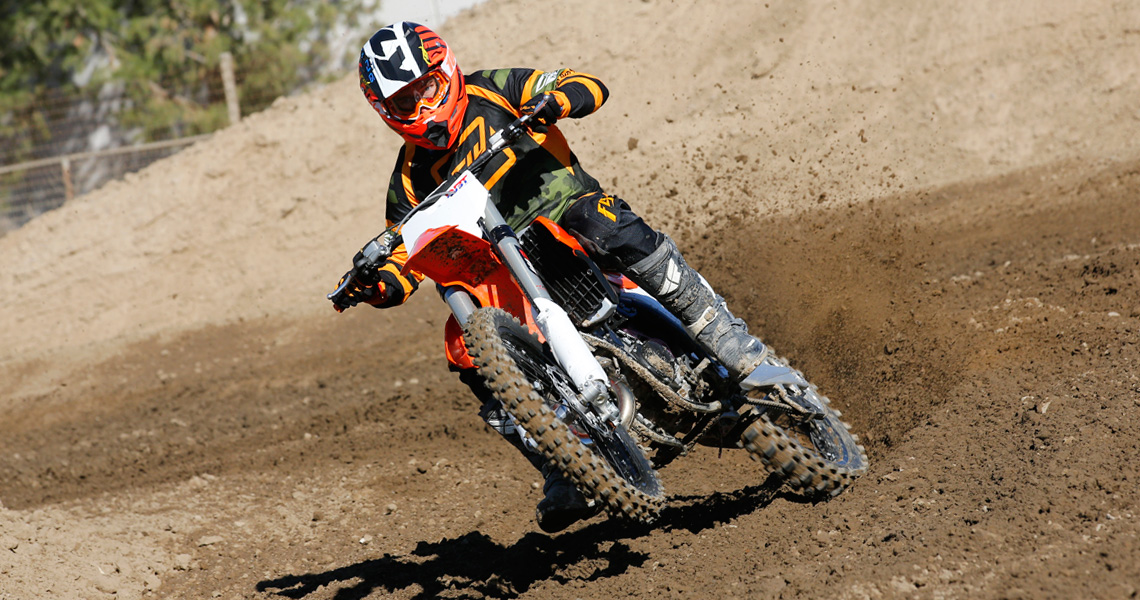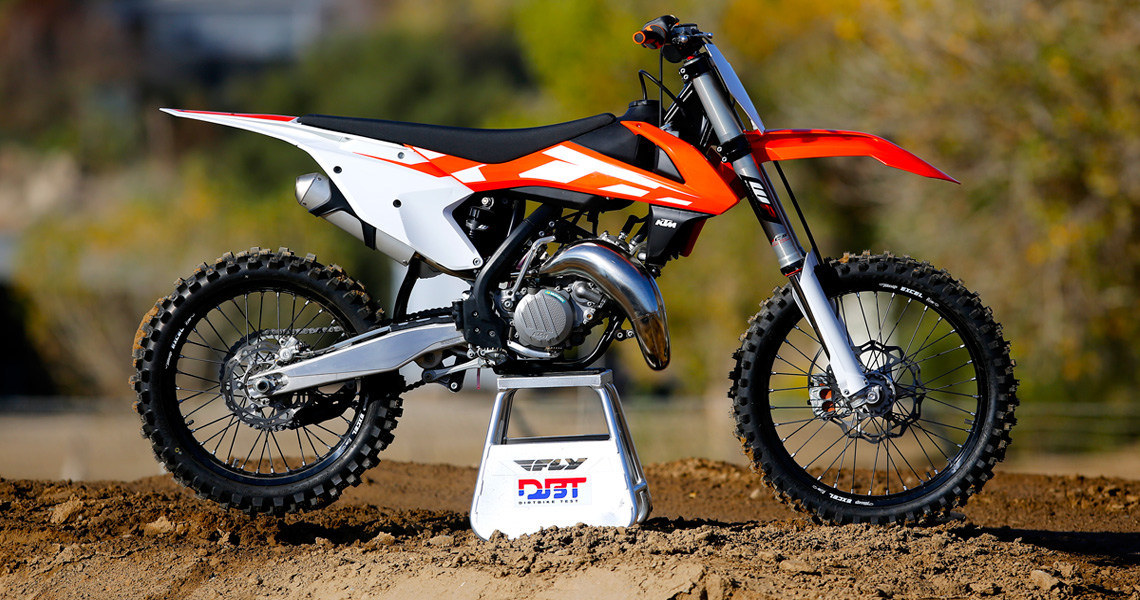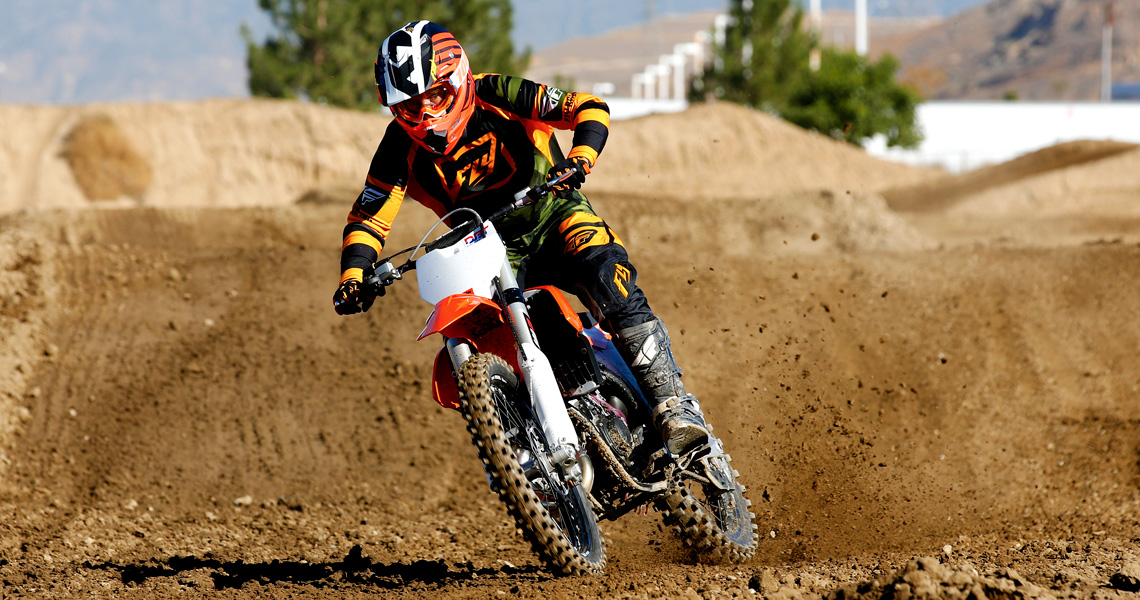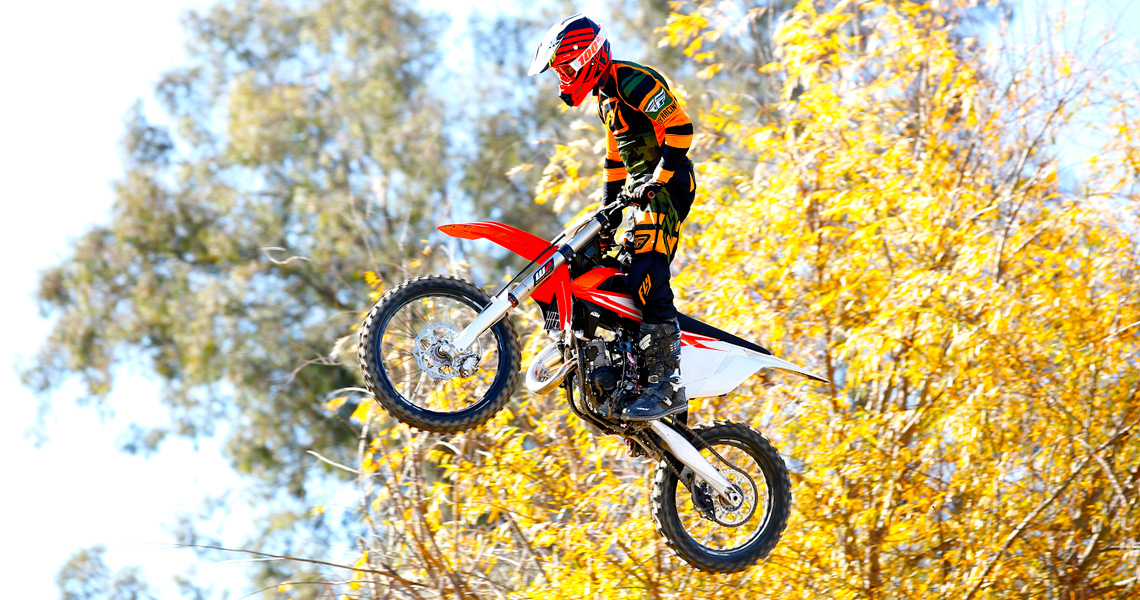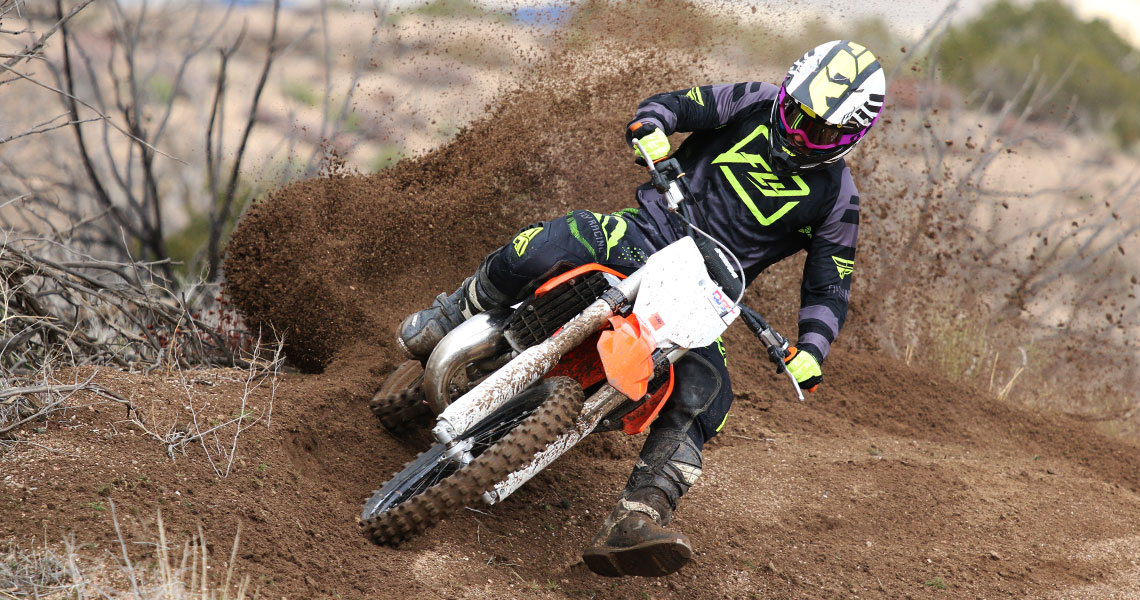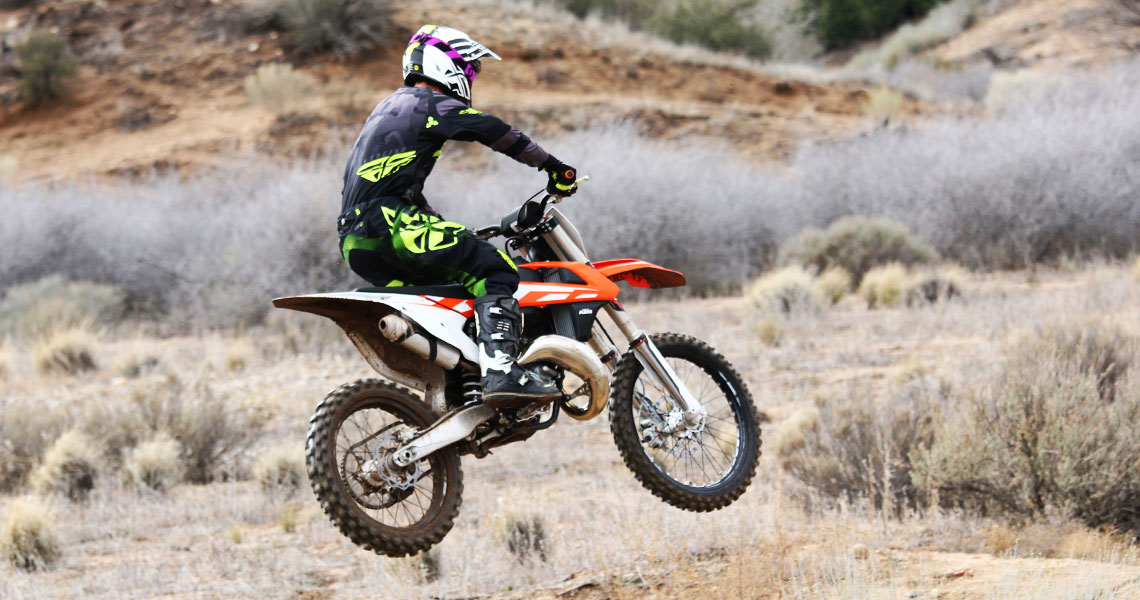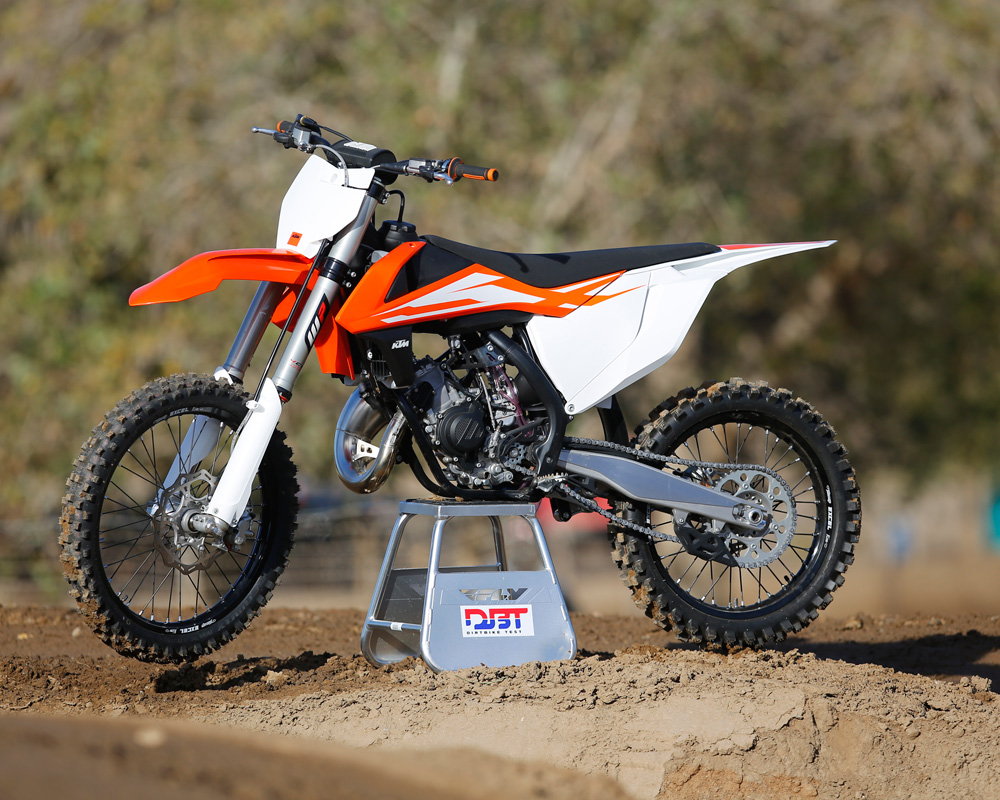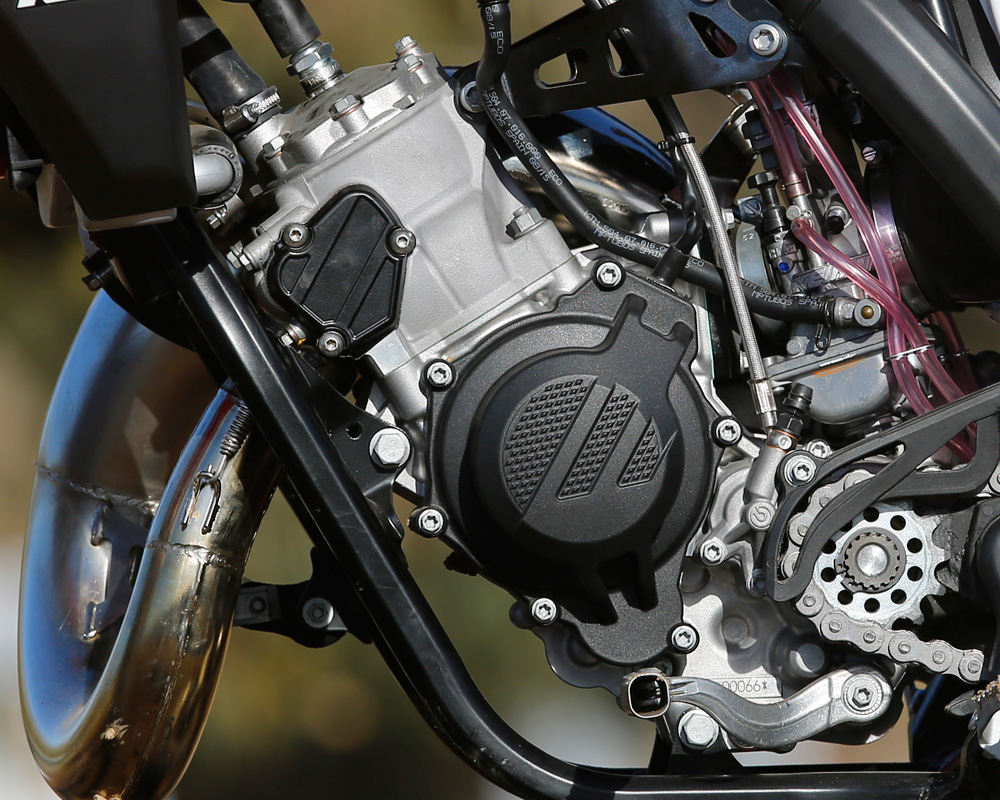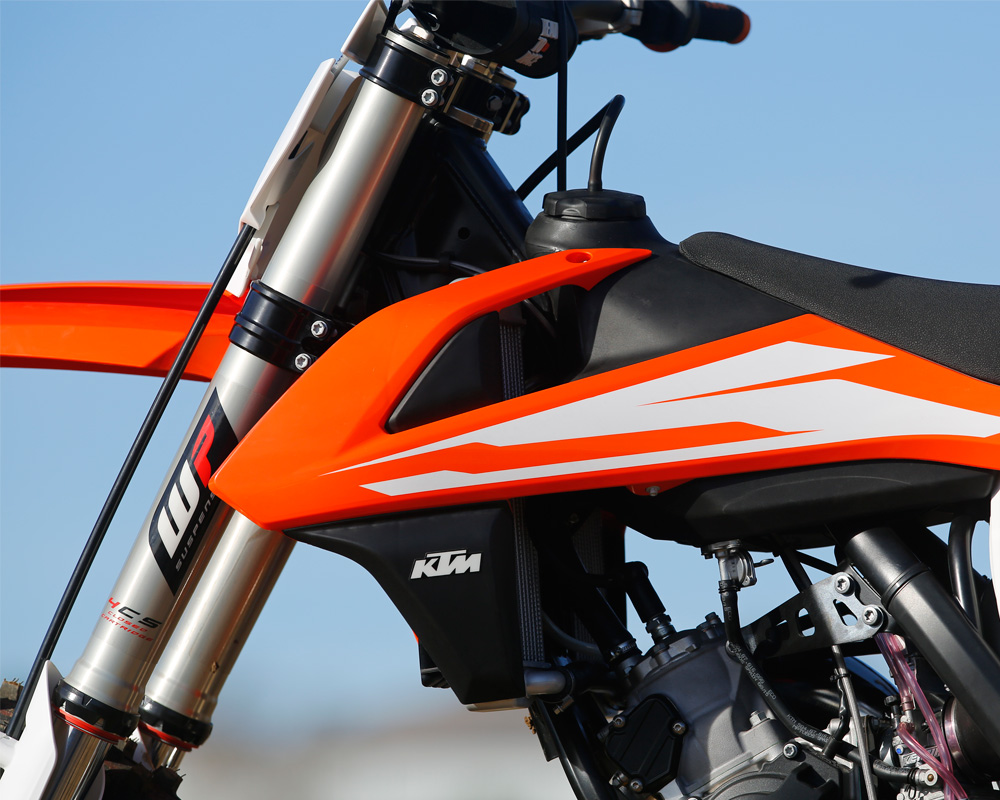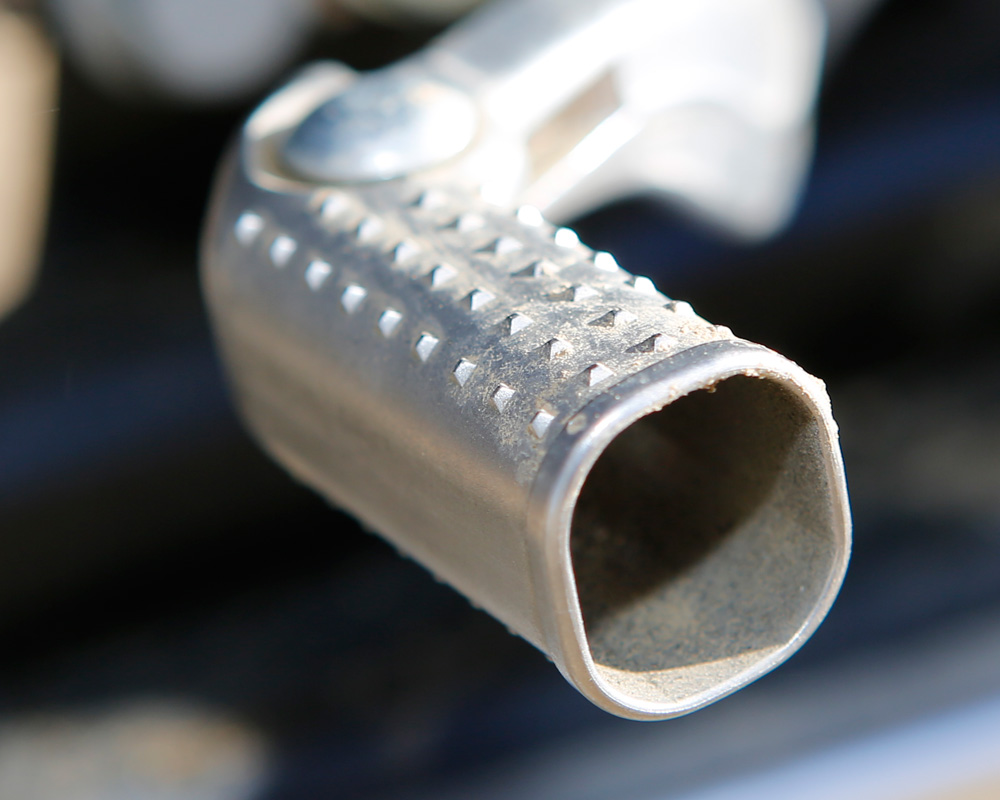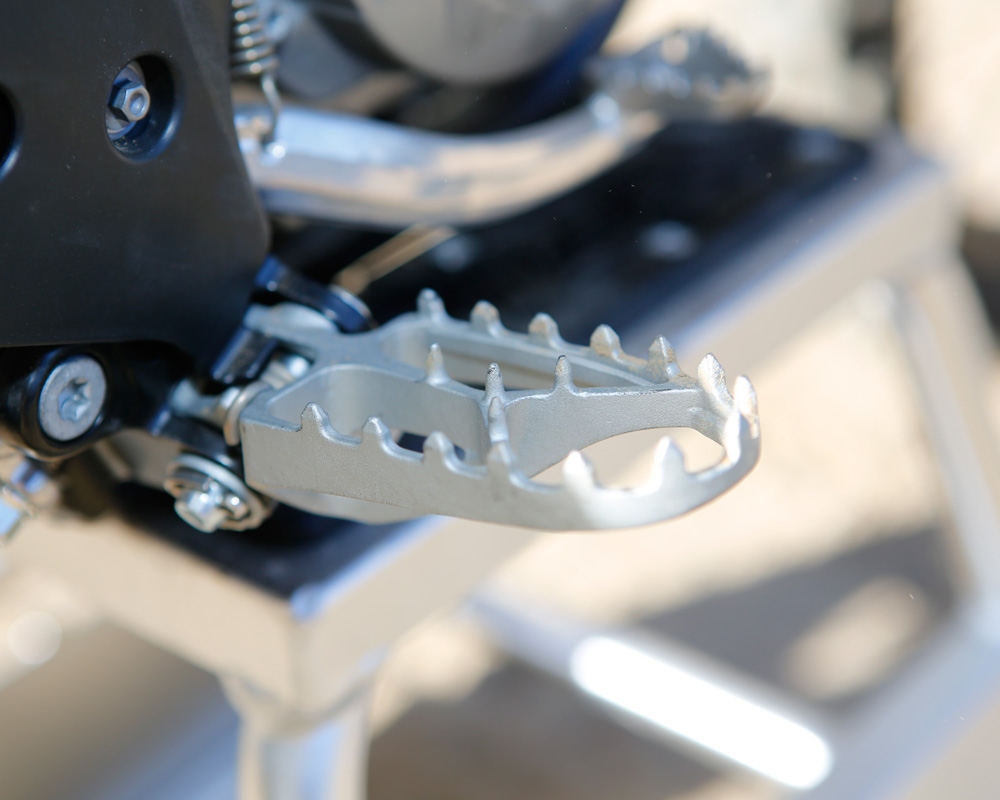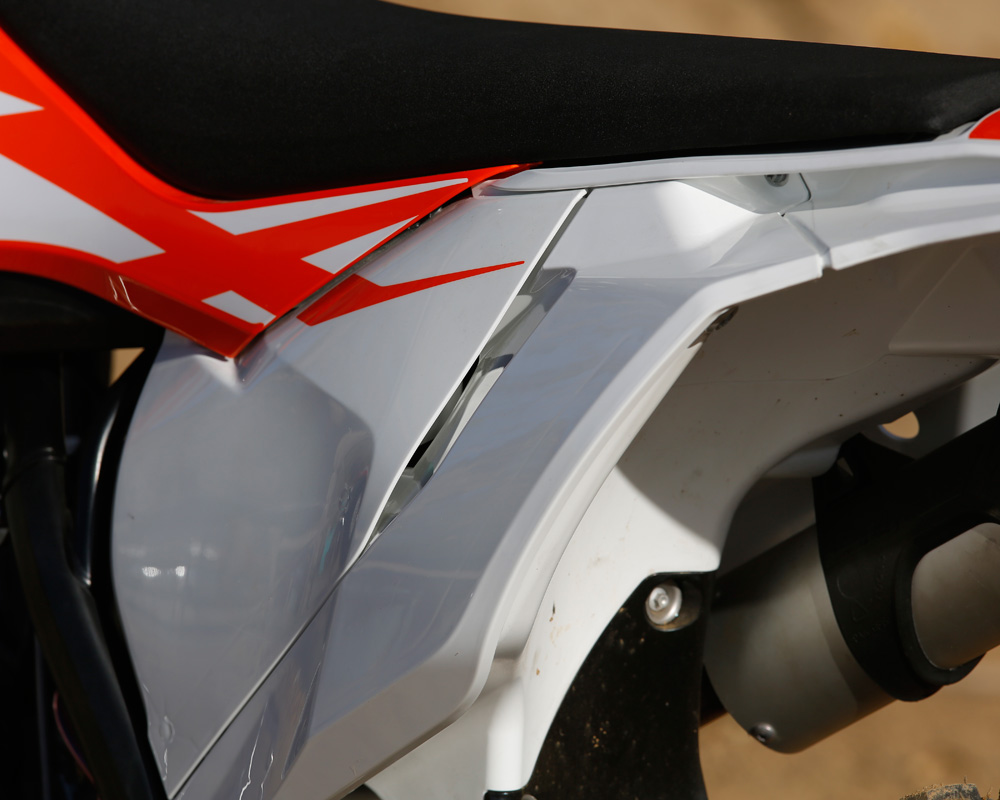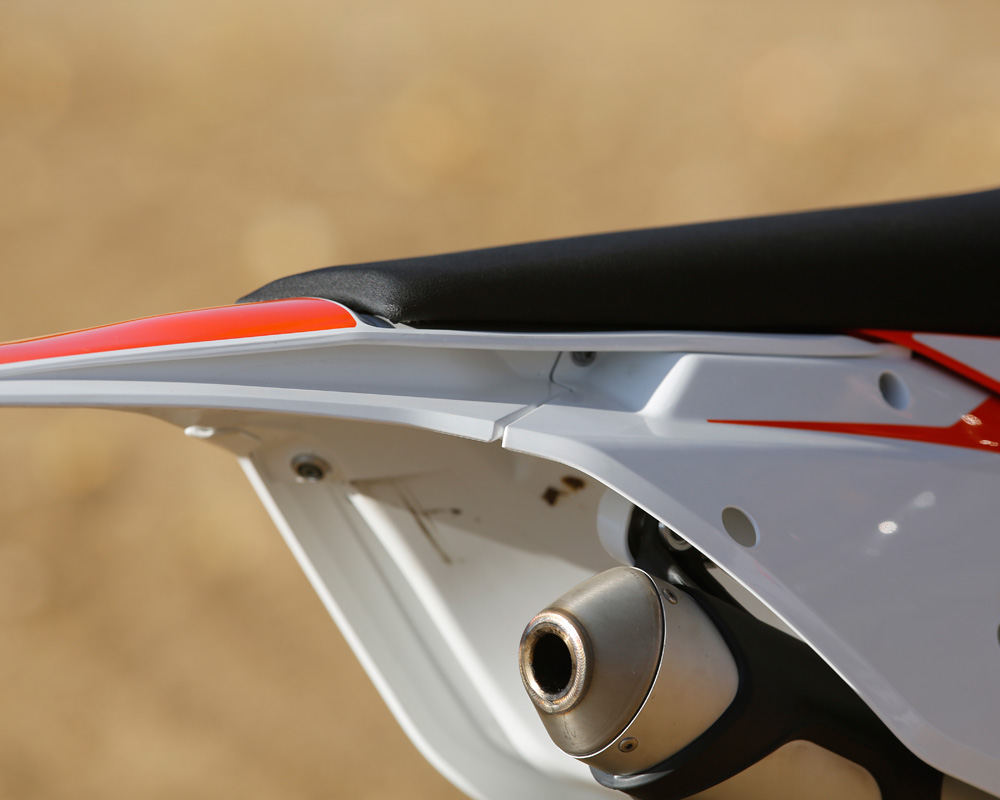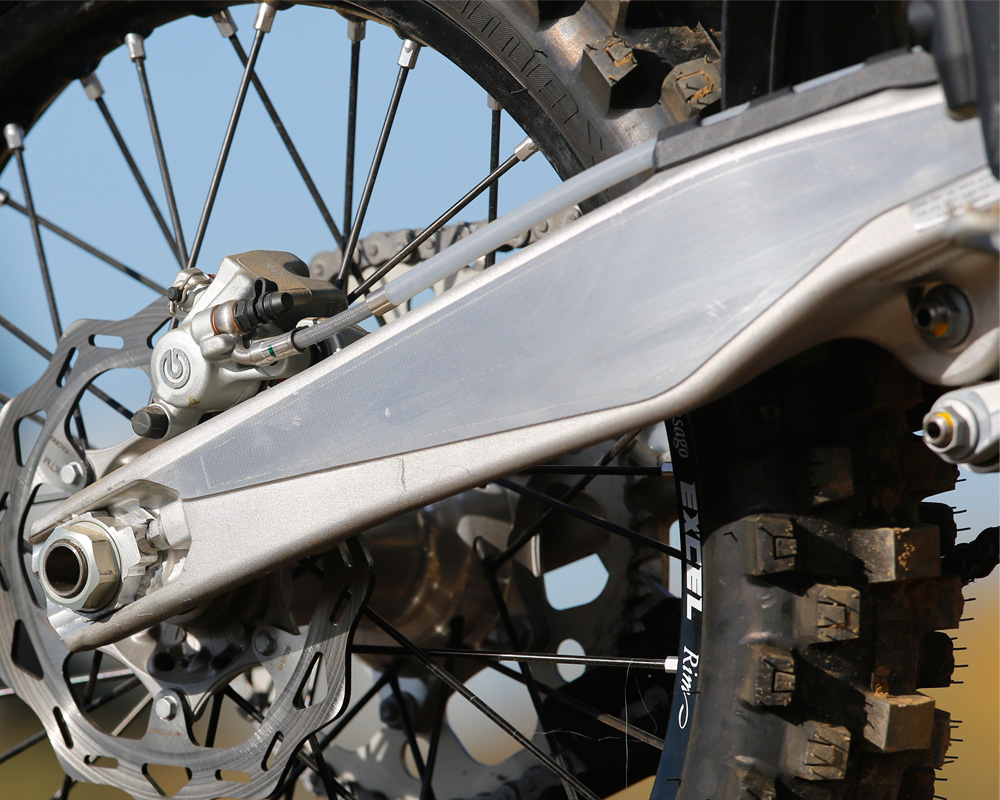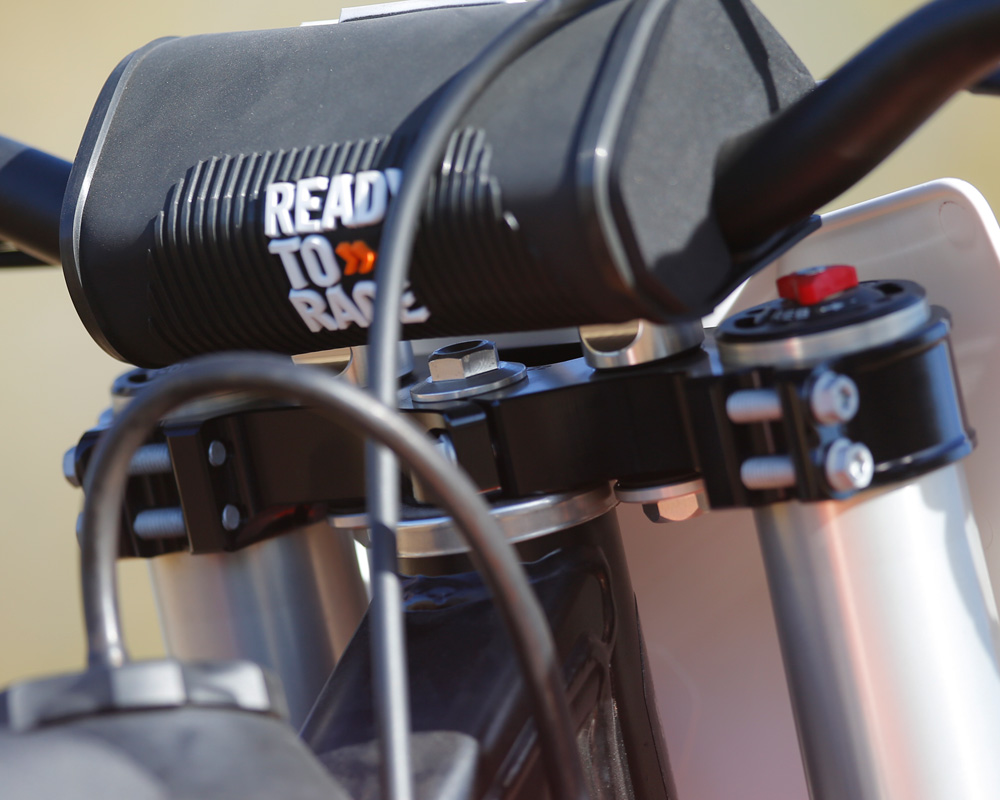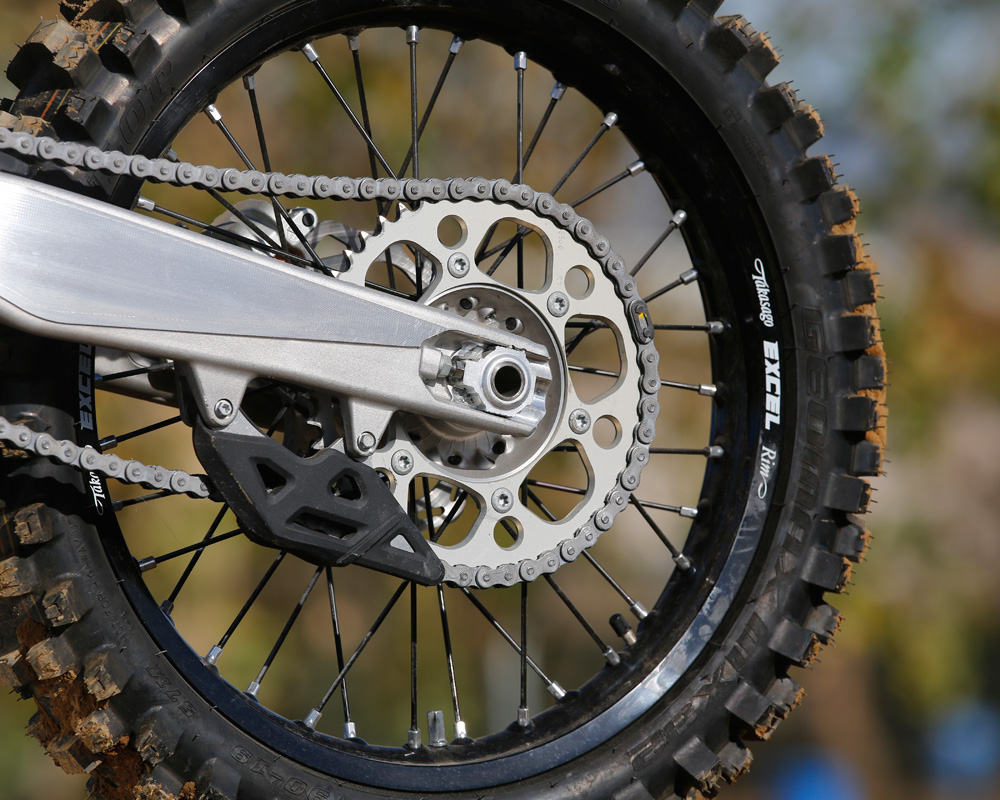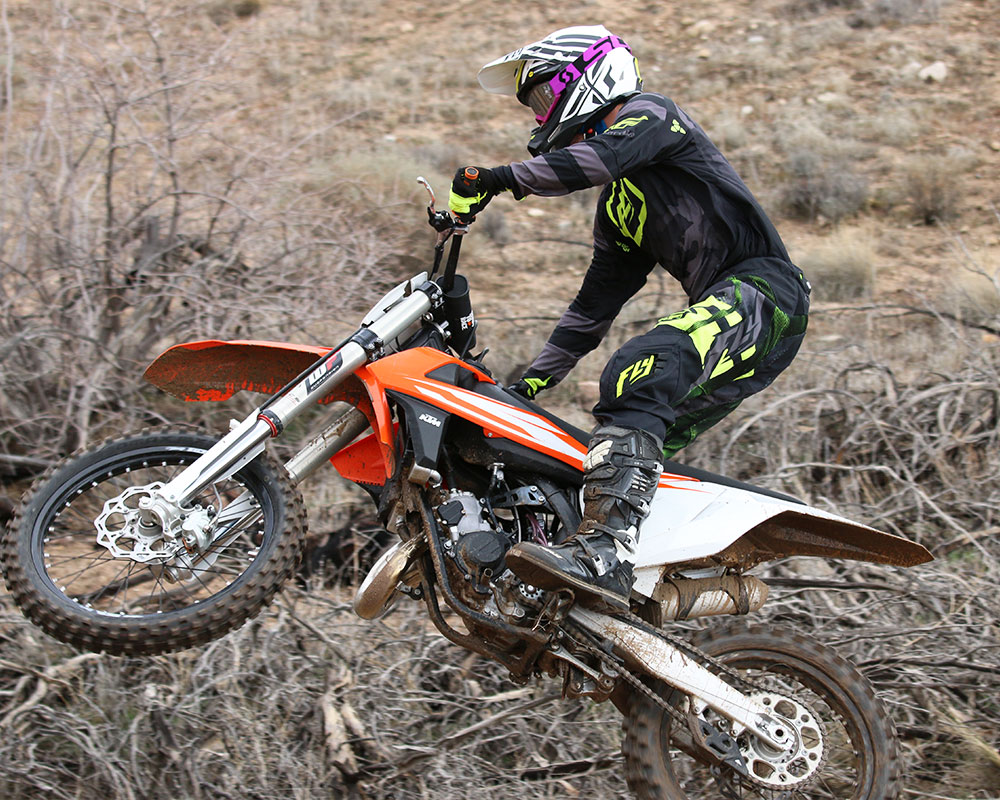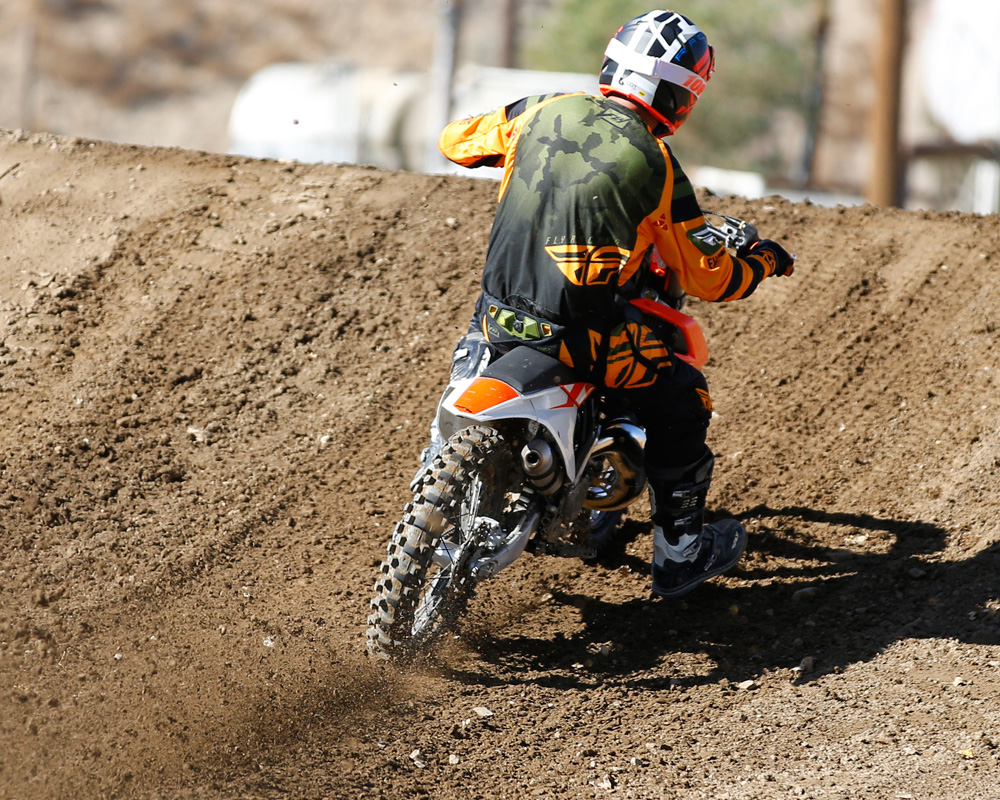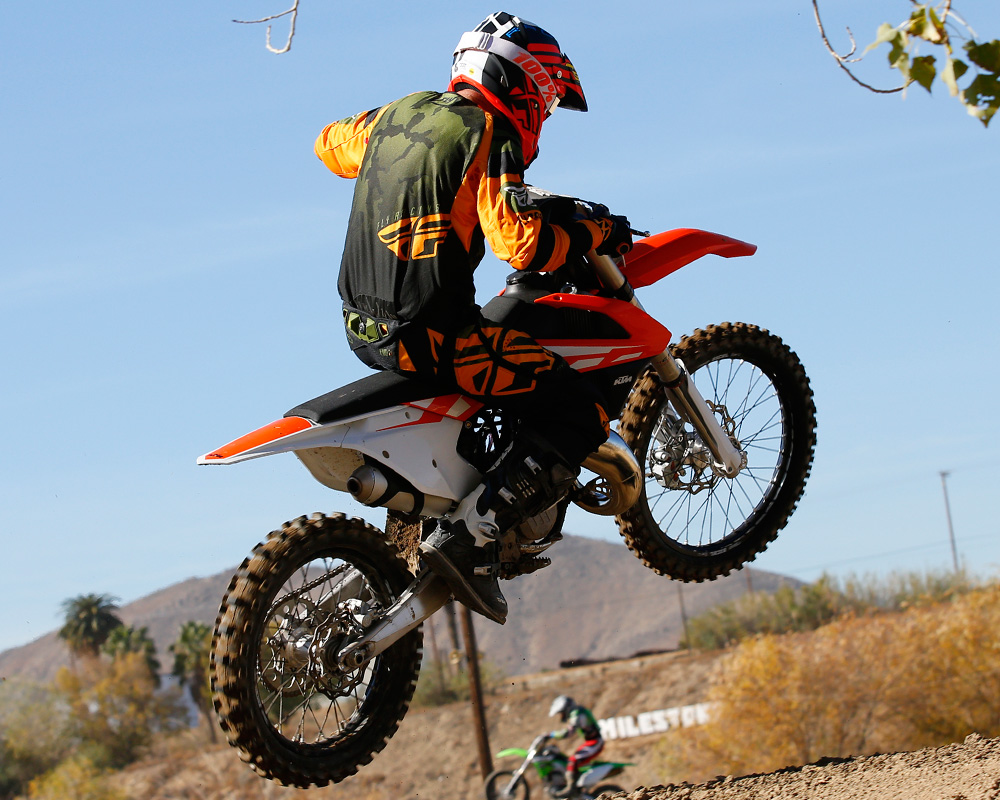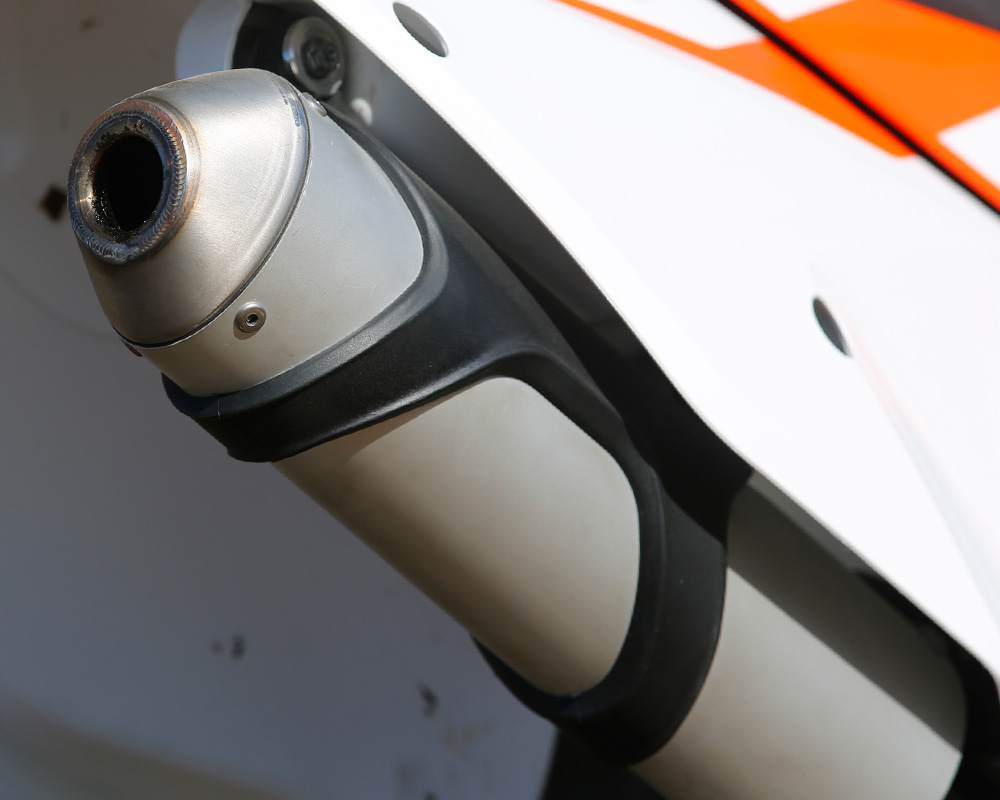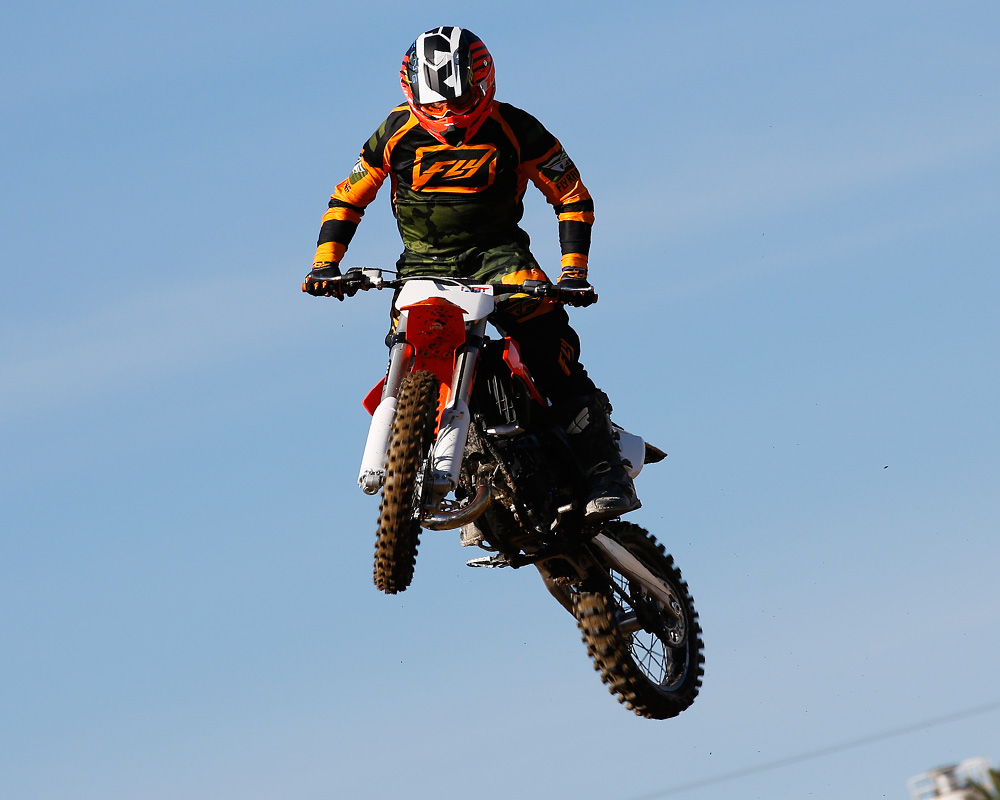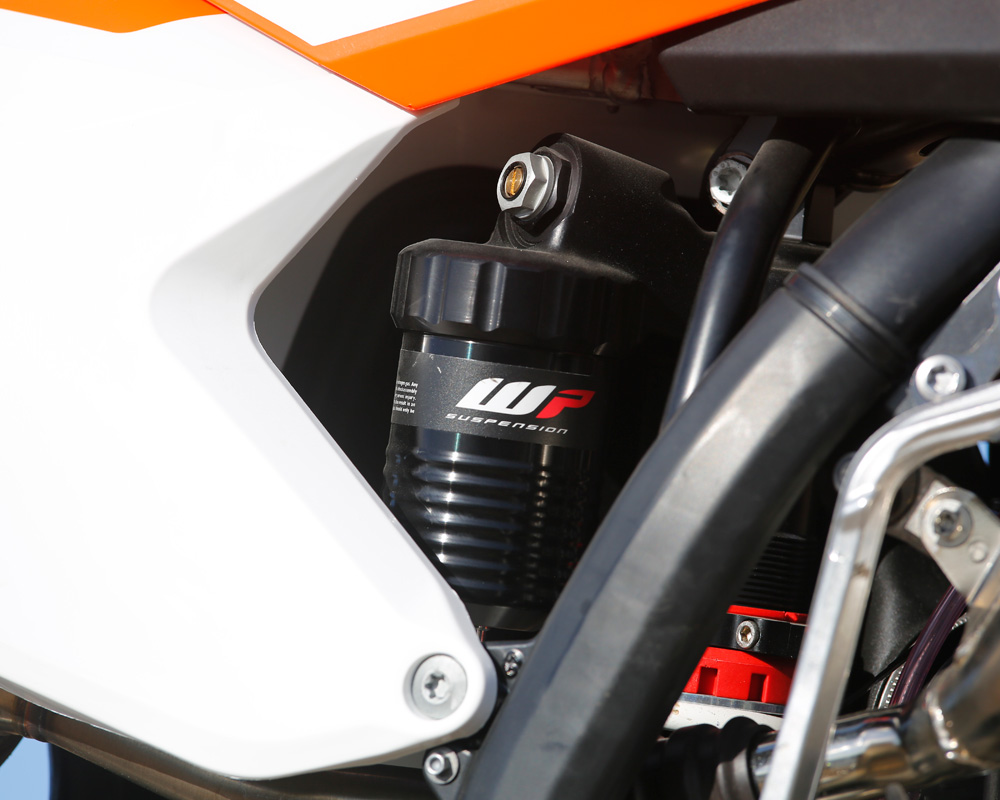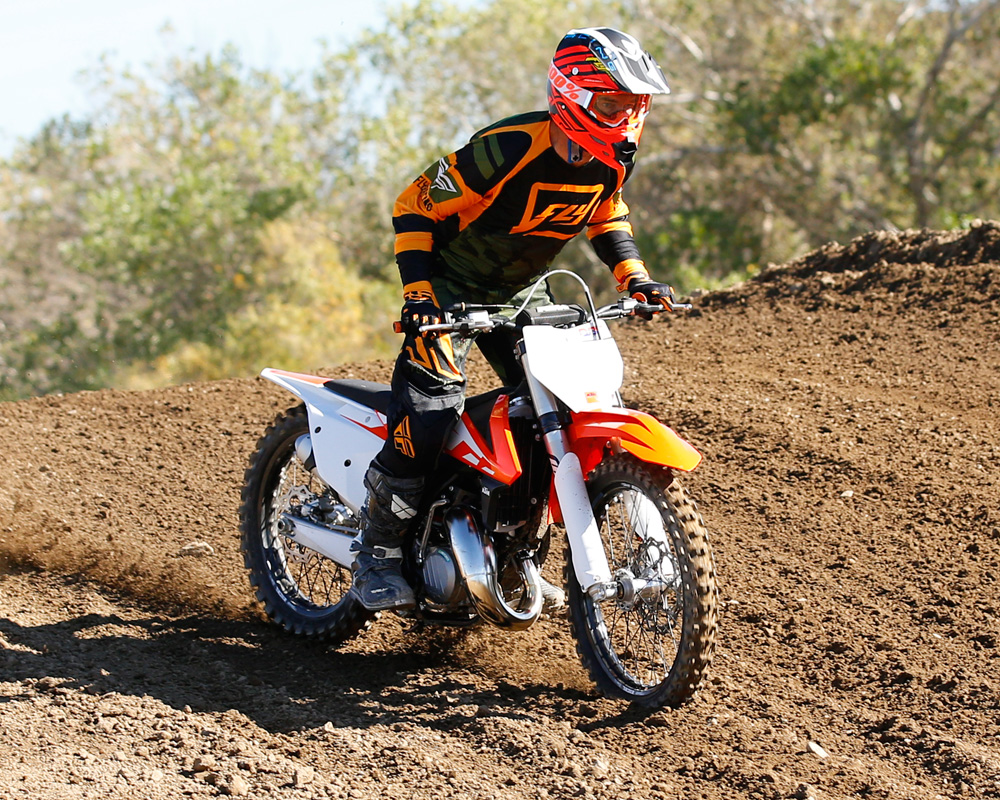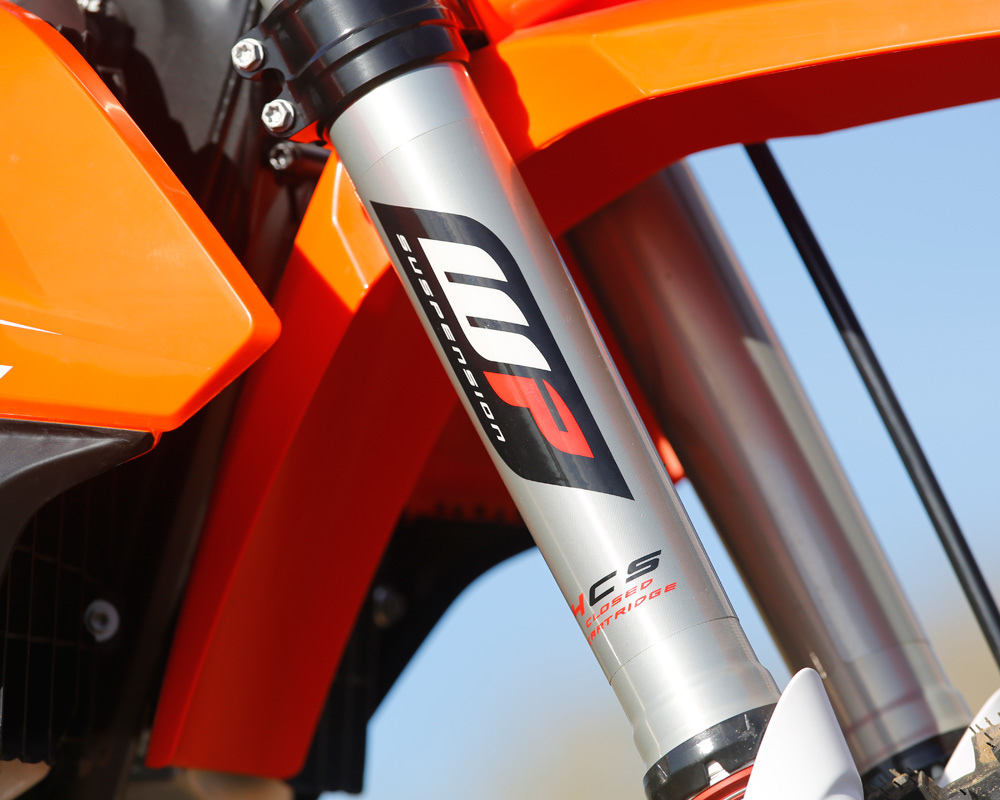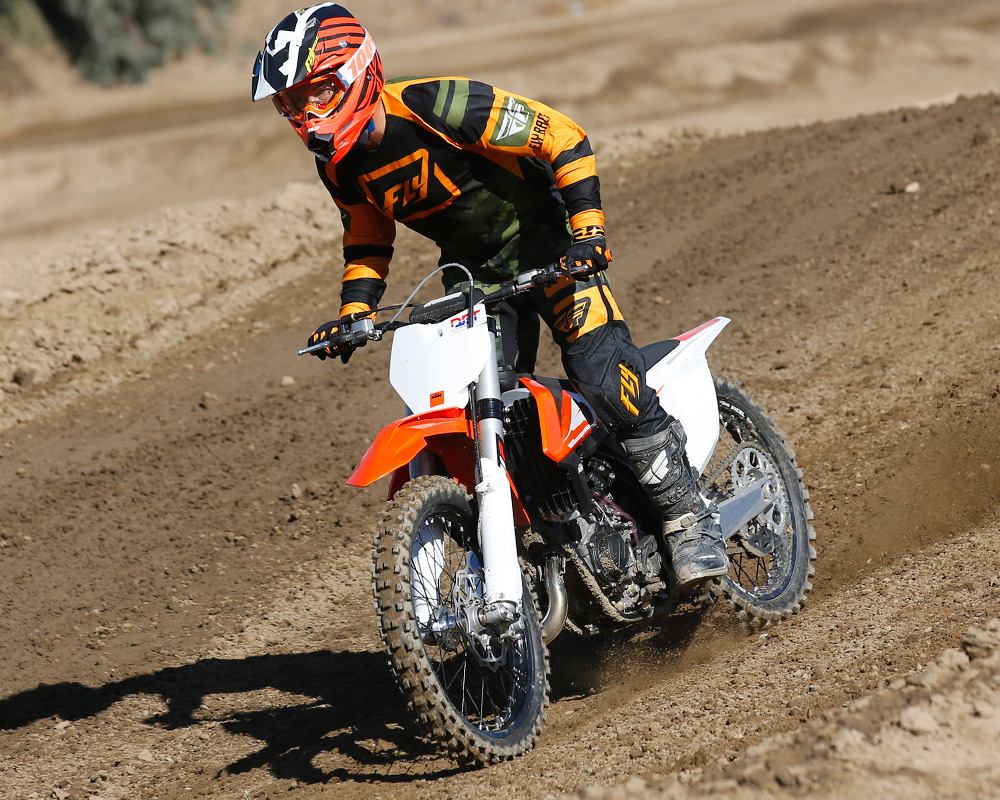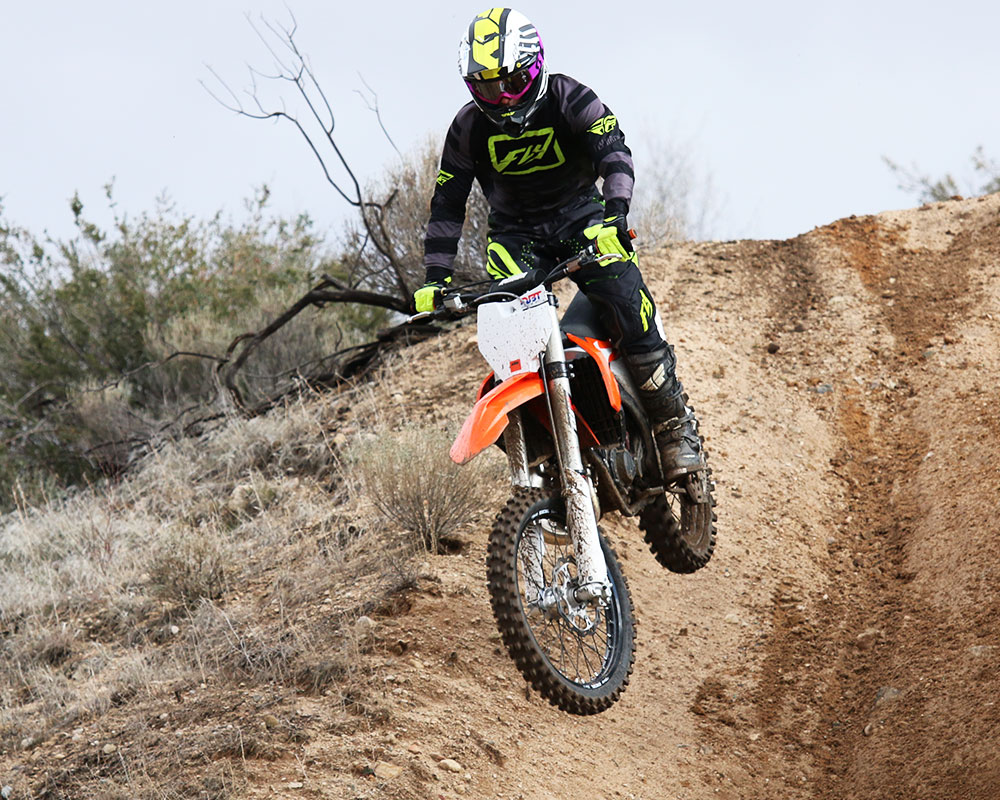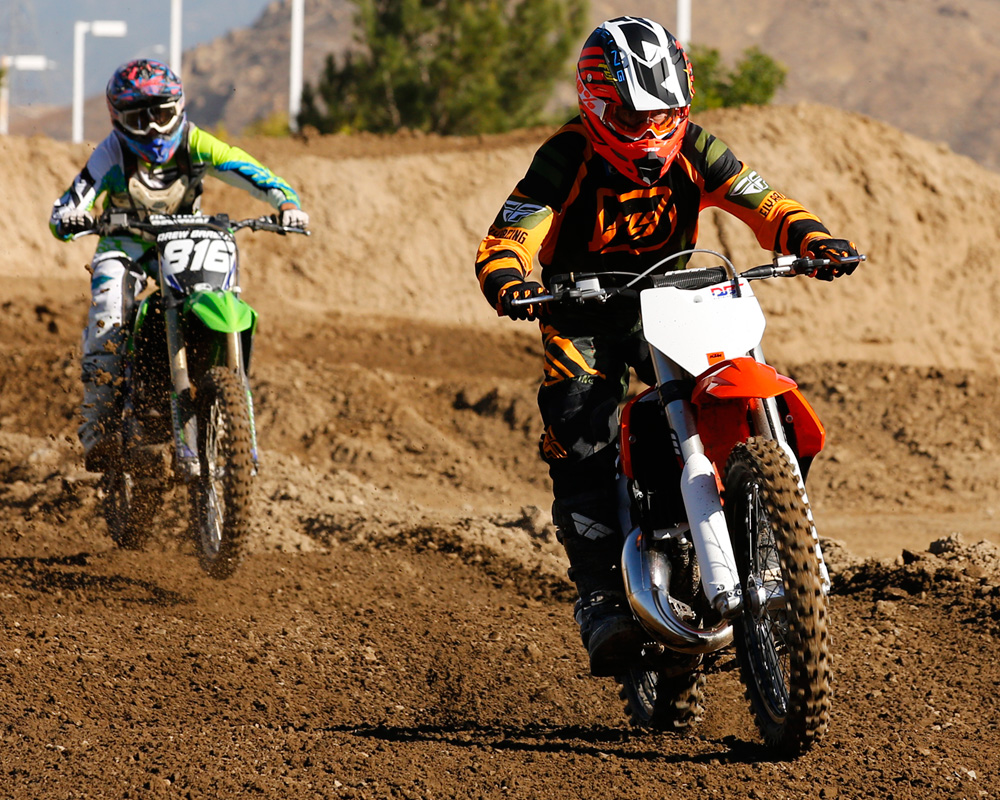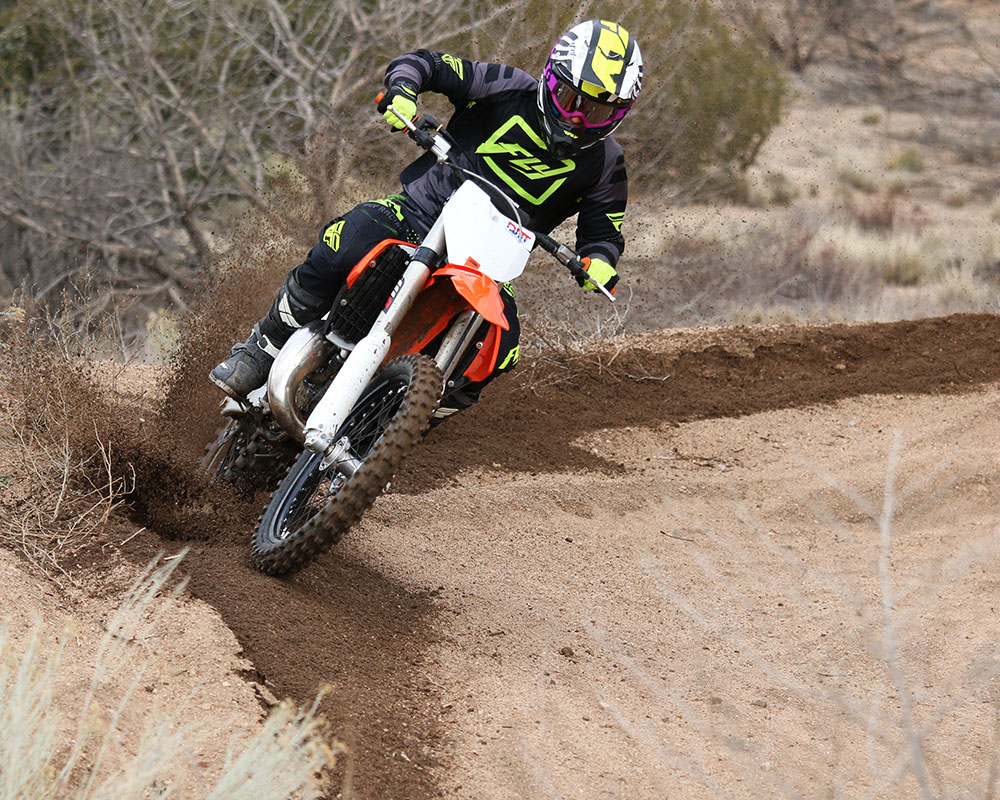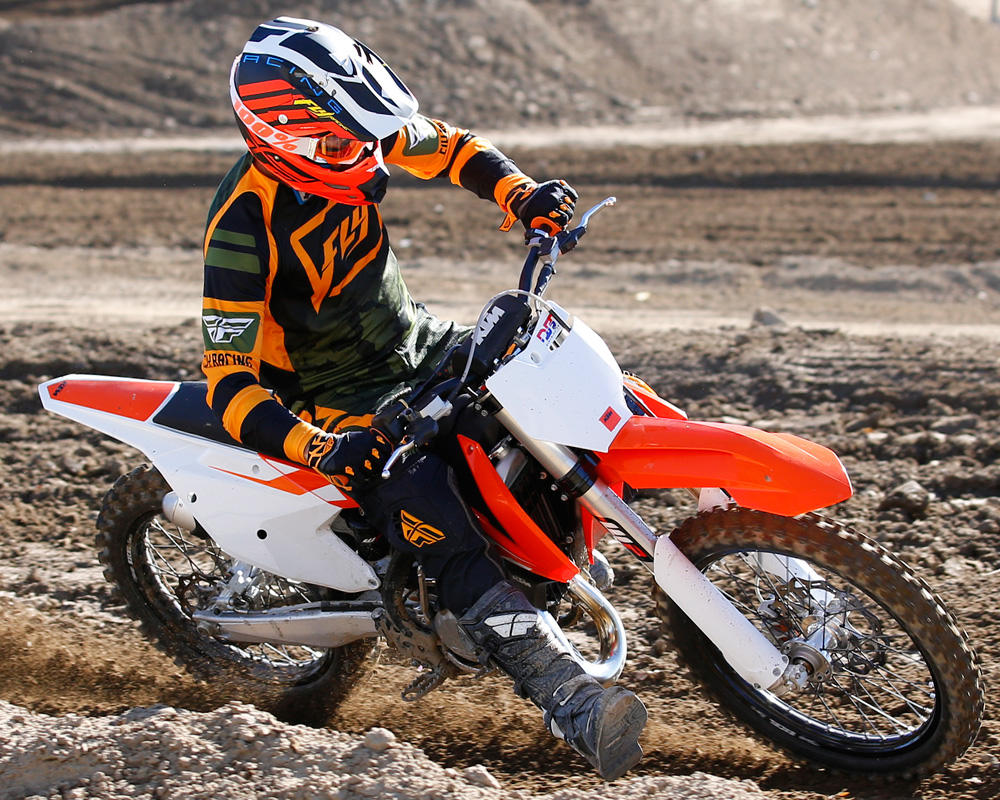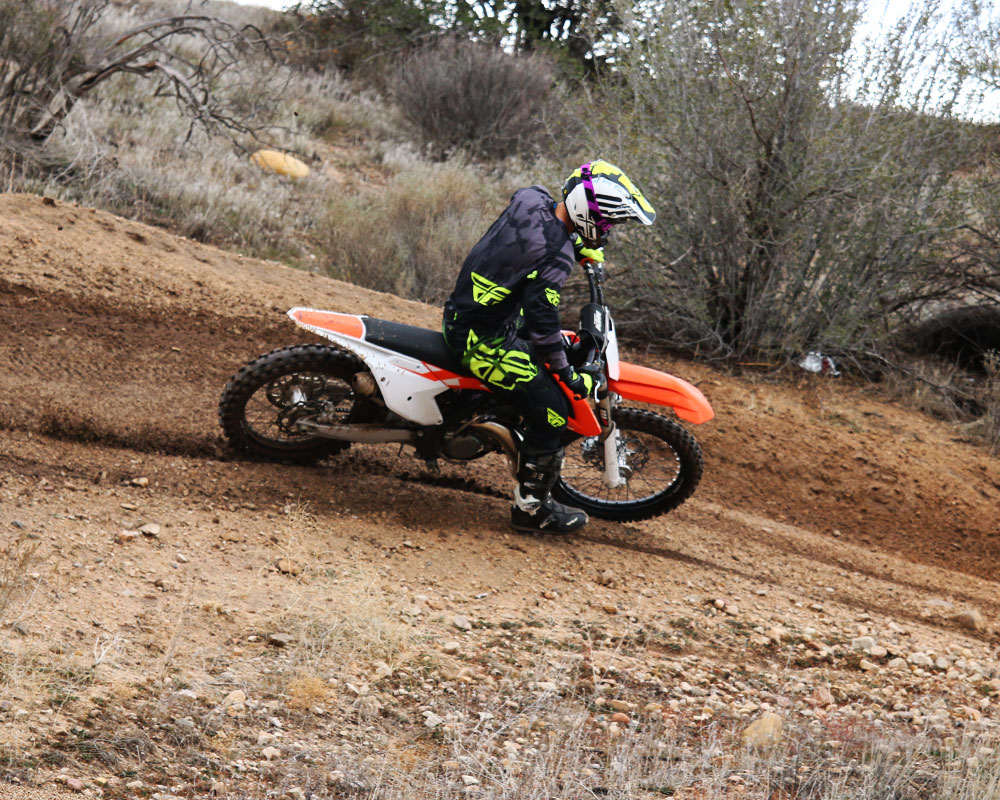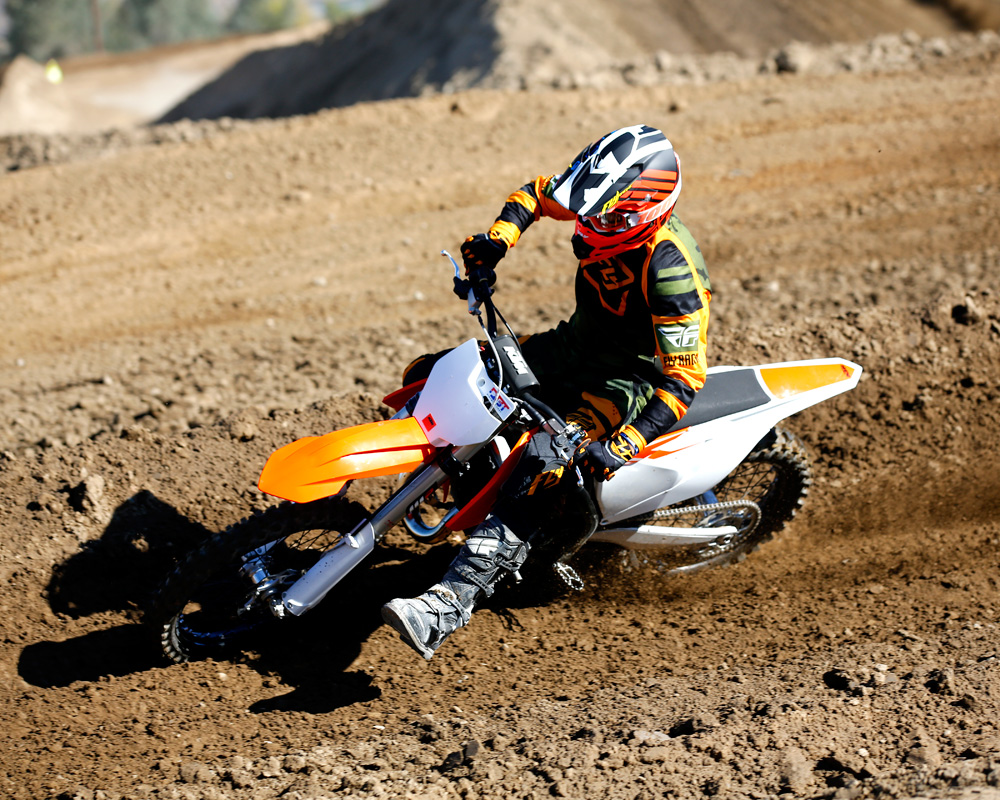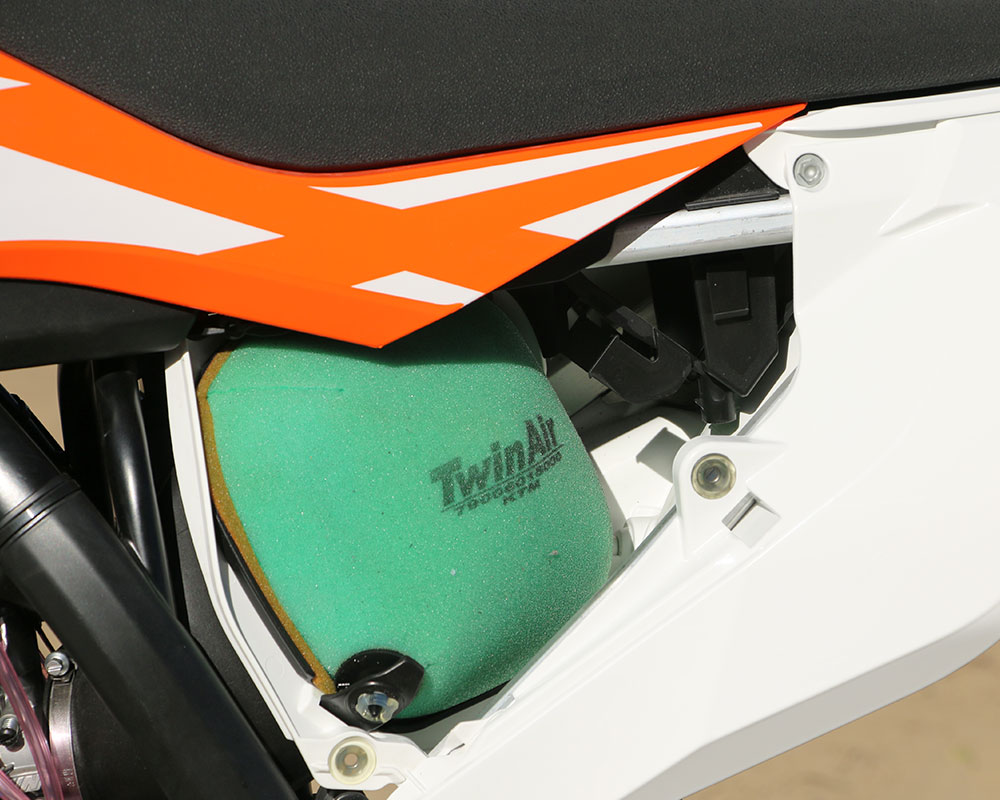2016 KTM 150SX
Keeping The Screamer Alive
MSRP: $6899
Introduction
- All-new for 2016.
- KTM is committed to two-strokes.
KTM is pushing two-stroke development along and with an all-new 125 and 150cc motor the company is showing its commitment to small bore riders all over the world. From the younger schoolboy racers who need a steppingstone to the full sized motorcycles from the minibike classes to riders who just prefer a smaller and much lighter machine. Having to compete with four-strokes in a lot of racing has made the 125 and 150cc two-stroke less popular but don’t think that just because they are out displaced that they are not a wise choice for a lot of reasons.
Changes
- Everything is changed.
- This is a Factory Edition two-stroke race bike.
KTM threw away the old design and started from scratch with the 125/150 engine. It’s layout raises the cylinder and crank location and rearranges the positions of the transmission shafts to make a more compact engine and also to alter the center of gravity on the motorcycle. Even on the lightest of the full-sized bikes they paid attention to this. The more vertical placement and the raising of the engine shafts as well as the shrinking of the circular items in the engine allowed a 4.4-pound weight reduction from the previous engine.
There is the casting in the engine where an electric starter could go and we know an XC version will come in 2017 using this, but for the SX weight and simplicity was a priority and for that there is kick-starting. Inside the cylinder has a new powervalve system where the side exhaust sub-ports are opening at a different and quicker ratio albeit later in comparison to the main powervalve flap. This helps keep the compression up as the RPMs rise. The pipe is specific to the 150SX as well.
The chassis is also all new and mirrors all of the current SX bikes in most ways. Also lighter and thinner than the previous design the 125/150 chassis has a different lower frame cradle and the two-stroke air box boot to make everything fit proper. The swingarm and linkage (also lighter) have a new shape and internal profile and different ratio acting on the shock.
Suspension wise KTM is sticking to the spring fork and WP’s 4CS system with updated settings. The shock also gets new valving specific to the 125/150. Small bits recieved all of KTM’s improvements to things like the footpegs (no dirt design), shifter (lighter, no dirt design), the new clip-in air filter, Galfer wave rotors for the brakes, CNC-machined hubs and Excel rims, Neken handlebar with ODI lock-on grips. The top triple clamp now has rubber dampers at the bar mounts.
Power
- A little more bottom snap but way better overrev in the 150cc.
- Excellent clutch action.
- Very responsive to powervalve and jetting tweaks.
Just how much power can a 150cc two-stroke make? Actually more than most people think. The trick is making that power spread out over a longer usable RPM range and that is what the KTM two-strokes have always been good at. Well, peak power is also class leading and very far up in the revs. For the new 2016 engine KTM wanted to give the bike more punch and hit off the bottom, and they did just a little bit but not at the expense of losing any top end power where this bike need to run if it is to be fast and competitive with a 250F. Where the 150SX saw the biggest improvement was on top and in how far it revved. Previous 150s would never really scream like the 125 did, they tended to sign-off just a little earlier. This one does not.
It has just a little more torque on the bottom compared to the 125 but where the 150 really shines is in the mid-range in comparison. Those extra CCs let the engine pull better from lower RPMs than a 125 so the shifting is not as critical and a rider can get a little more pull from each gear. Before shifting was similar in quantity to a 125 but by adding the additional pull on top most riders will shift the 150 less, especially lighter riders.
The 150 starts easily and is jetted pretty spot on for average elevations and normal temperatures. We were able to get a little sharper throttle response with a leaner needle clip position when we rode at 3000 ft. altitude and on very cold days the engine liked a richer clip position. The bike is not that sensitive but a rider who can feel small changes will notice crisper jetting. Additionally the powervalve is adjustable and very effective at getting every ounce of power out of the bike. We understand they set each one on the dyno at the factory for peak power but have also noticed that some bikes run better than others too. A quick half-turn in either direction of the adjuster followed by a run through the gears will usually tell you if the valve is set properly. We noticed that the pick-up when you land under a load can really be improved with fine-tuning of the valve as well as how far the bike will rev. It could also be used to tame the power delivery for novice riders or low traction situations.
The transmission spacing has not changed in ratios from previous bikes and the six-speeds are well spaced and stock gearing is just about right for most tracks and riders. Heavier riders will like going to a 49 or 50 tooth rear sprocket for some added pull. The hydraulic clutch is great and pull and action are smooth and consistent, even with all the abuse it takes. The durability is very good as well, pretty standard for KTM clutches.
Suspension
- Much improved front forks.
- Very adjustable, but different in results.
If there was an area the 2016 KTMs have been getting a little beat up on it is in the suspension department--less than in previous years, but still. It has a lot to do with the perception of WP more than the actual performance, but there have been some issues as well. The 4CS fork is definitely different in feeling than most other upside-down forks and with most manufacturers having switched to an air-spring front fork, the KTM stands out even more. The downside to the 4CS has been a initial or mid-stroke stiction and the inability for riders to figure out the adjustments. KTM worked hard on the stiction issue (it was actually a valving issue) to get the fork moving easier and staying more fluid in stroke. It was especially noticeable on the 125/150, a bike that is lighter and therefore more sensitive to this. For sure it is improved but some riders, especially lighter riders, may feel the 150SX’s fork is still a little harsh.
But it can be tuned out, or at least minimised with clicker settings. But it isn’t as simple as going softer. We have found the 4CS fork’s external adjusters work more like mid-speed valves than low speed. Therefore the seem to adjust the active ride height as much as they do the compression or rebound feeling. So a lot of the times stiffer, or getting the fork to ride higher in the stroke will make it softer and more compliant. And the clickers really do work, you just have to learn which ones to turn and for what. We were actually a bit stiffer with our lighter and fast rider on both compression and rebound on the fork but we backed that up by sliding the fork up in the triple clamp a little. Out back the shock and its adjustment is quite standard and the feeling was praised as soon as we got the fork feeling more compliant. Heavier riders were not so picky about the front until we got to a whoopy sand track and stiffer everywhere was the call.
We liked the rear between 105-110mm of sag and then used the high-speed in the shock to tune around the stability feeling. The rear takes a while to get harsh and if anything most riders were just trying to get it to ride higher in the stroke, especially our bigger riders who were in reality too heavy for the stock rear shock spring. KTM says the spring is chosen for riders in the 135-150 weight range but we were easily getting away with 175lb. Riders on the bike.
Chassis - Handling
- Light feeling like no other bike.
- Great turning precision.
- Very roomy chassis.
The 150SX is hitting the scale at under 200lb. Without gas. It was 209.5 full on our scale and that is very light. Everything about this bike feels light and feathers, there isn’t another full-sized motorcycle that is this weightless. Combined with very little rotational mass spinning around inside the motor, handling is insanely critical. KTM did a really good job and it shows how potent this chassis really is. Considering that basically the same chassis is doing work on 450cc four-strokes, one would expect it to be too stiff and rigid. It isn’t and the precision on the front wheel for steering was excellent for faster and more aggressive riders. For being this precise there isn’t the too stiff part where the bike kicks the front end on chop or steps out the back end on the same. It is very planted for such a light bike provided your suspension is set proper. Our experience was when the bike felt compliant it stuck to the ground. Of either front or rear felt harsh then it didn’t and some setting was needed. For sure the bike was sensitive to ride height and balance front to rear, a lot of this could have been from the wide range of rider weights we tested with, especially the lighter riders needing the front end to set in turns while still having enough sag to keep the stability on the faster straights.
We were able to get every rider happy but it, like tuning the power with the powervalve, took a rider who could communicate a little bit of feedback on how the bike felt after changes. This bike is very adjustable, like all the KTMs. Surily helping the feel of the chassis is the rubber mounted handlebar clamp (this takes some of the spike out of the bump hits) but the new frame seems to have reduced even further the transmission of bump impacts to the rider. The flex definitely has been modified to absorb where it needs to and stay stiff when it has to. Being thinner through the tank and seat as well as flatter makes moving around seamless and where the rider connects to the bike the integration is perfect. The overall cockpit has definitely shrunk just a bit from previous KTMs that were exceptionally roomy but it is still never cramped for riders up to 6 feet tall. The footpegs have excellent grip and there are spots to dig in knees and ankles without hangups. The bike is narrow at the back too with no bulges.
Working on the bike is simple with routine maintenance basically requiring air filter and transmission fluid changes only. The top end should last an easy 20-hours for hard riders and 30-40 for novice riders who are less hard on it. At least this has been our experience with some KTM 125 and 144s we have owned in the past and we see no corner cutting in durability with the new engine. We put over 15-hours on our bike after it had spent a fair amount of time on FMF’s dyno testing pipes. It did not feel like it ever lost any power and inspection through the exhaust port had the top end looking perfect when we returned it.
Conclusion
- A 150cc bike that is already modified for you.
- High-quality KTM parts and durability.
- Can compete with four-strokes but at a disadvantage of shifting.
The only real competition for this bike is from kitted Yamaha YZ125s and from smaller manufacturers like TM. Basically for the money the KTM blows them away because it comes perfectly set up and as the slogan says, “Ready To Race”. There just isn’t a turn key 150cc except for this bike.
But the two questions are, “Can it compete in the 250F class?” And “Does it have that Yamaha YZ125 mid-range punch?” The answer to the first question is yes, it is competitive in the 250F class but at a disadvantage, especially as the rider gains weight. The peak power of the 150SX is very close if not a bit more than most 250Fs, but the power length and spread is not as long. That takes more shifts and a rider that is making less mistakes to maximize the small power advantage and lighter weight of the two-stroke. And there is no doubt that tracks have “four-stroke lines” so the cut and thrust-ability of the two-stroke or the flow it needs to keep speed ud can be blocked by the torque a thumper has. The same rider will do better on a four-stroke in our honest opinion and that is why you don’t see any racing at the highest levels. But a rider racing and learning on a 150cc two-stroke, especially coming off two-stroke mini bikes will be a better rider when four-stroke time comes.
As much as KTM went after a more aggressive power delivery it still does not have the bottom to mid-range snap of the Yamaha YZ125. Just like the YZ125 does not rev like a KTM. The KTM 150 for sure makes more power everywhere than a 125 but the delivery sometimes masks this. The Yamaha chassis feels smaller and a bit more nimble but definitely not as light as the KTM is now. It is close but KTM’s redesign of the entire bike has it a step ahead of what Yamaha did back in 2005.
And the one word we omitted from the entire test was "fun". That is because it is overplayed and used as an excuse for buying a small bore two-stroke MX bike. This bike really makes no excuses and it is one of the most fun bikes you can buy. There is nothing like the feeling of holding a bike wide open and being able to control it. That will happen a lot more on a bike like this KTM than any other. It's slightly boosted power when compared to 125cc bikes even adds more smiles as well.
The simple answer answer is that this is the best 150cc motocross bike that you can buy.
Recent Product Tests
What Others Said

http://motocrossactionmag.com/bike-tests/ktm-tests/mxa-race-test-2016-ktm-150sx

http://motocross.transworld.net/news/2016-ktm-150-sx-first-impression/#83fVTMylrisp3UMr.97
Leave a Reply
